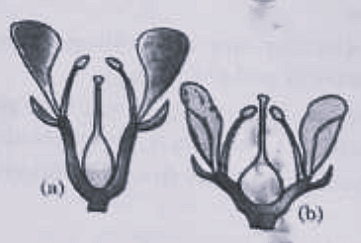Question:
The diagram given below denotes the various parts of a typical flower. Identify the labelled parts A, B, C and D and choose the correct option :
The diagram given below denotes the various parts of a typical flower. Identify the labelled parts A, B, C and D and choose the correct option :
Updated On: Apr 14, 2024
- A = Petals, B = Sepals, C = Stamens, D = Pistil
- A = Sepals, B = Pistil, C = Petals, D = Stamens
- A = Sepals, B = Pistil, C = Stamens, D = Petals
- A = Sepals, B = Petals, C = Pistil, D = Stamens
Hide Solution
Verified By Collegedunia
The Correct Option is C
Solution and Explanation
Answer (c) A = Sepals, B = Pistil, C = Stamens, D = Petals
Was this answer helpful?
0
0
Top Questions on The Flower
- Identify the set of correct statement:
A. The flowers of Vallisneria are colourful and produce nectar.
B. The flowers of waterlily are not pollinated by water.
C. In most of water-pollinated species, the pollen grains are protected from wetting.
D. Pollen grains of some hydrophytes are long and ribbon like.
E. In some hydrophytes, the pollen grains are carried passively inside water.
Choose the correct answer from the options given below- NEET (UG) - 2024
- Biology
- The Flower
- Match List I with List II
List I (Types of Stamens) List II (Example) A Monoadelphous I Citrus B Diadelphous II Pea C Polyadelphous III Lily D Epiphyllous IV China-rose
Choose the correct answer from the options given below:- NEET (UG) - 2024
- Biology
- The Flower
- Which of the following is an example of actinomorphic flower?
- NEET (UG) - 2024
- Biology
- The Flower
- Identify the type of flowers based on the position of calyx, corolla and androecium with respect to the ovary from the given figures (a) and (b).

- NEET (UG) - 2024
- Biology
- The Flower
- Identify the correct description about the given figure.

- NEET (UG) - 2024
- Biology
- The Flower
View More Questions
Questions Asked in KCET exam
- The minimum value of \( 1 - \sin x \) is:
- KCET - 2025
- Inverse Trigonometric Functions
Match List-I with List-II and select the correct option:

- KCET - 2025
- Bond Parameters
- The maximum value of \( z = 3x + 4y \), subject to the constraints \( x + y \leq 40, x + 2y \geq 60 \) and \( x, y \geq 0 \) is:
- KCET - 2025
- Linear Programming Problem
- Given, a current carrying wire of non-uniform cross-section, which of the following is constant throughout the length of the wire?
- KCET - 2025
- Current electricity
- If the number of terms in the binomial expansion of \((2x + 3)^n\) is 22, then the value of \(n\) is:
- KCET - 2025
- Binomial theorem
View More Questions
Concepts Used:
Structure of a Flower
The flower structure comprises four major parts or whorls—known as the calyx, corolla, androecium, and gynoecium.
Diversity of Flowers:
Flowers come in a range of sizes and shapes, but their anatomy, in general, is the same: sepals, petals, stamen, and carpel. A whorl, or circular positioning, is created by arranging these parts in a circular pattern.
Flowers come in various forms:
- Complete flower - The sepals, petals, stamens, and pistil all constitute a complete flower.
- Incomplete flower - An incomplete flower is one that lacks one or more of these structures.
Parts of a flower:
- Vegetative Part: A flower's vegetative component comprises the following:
- Petals
- Sepals
- Reproductive Part: Flowers consist of the reproductive organs of the plant. A flower's reproductive parts involves the following:
- Pistil
- Stamen
- Leaf
- Stem
- Receptacle